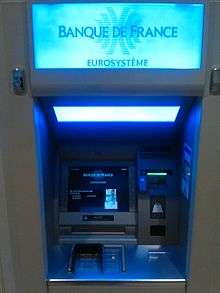Bank of France
 Logo | |
| Headquarters | Paris, France |
|---|---|
| Established | 18 January 1800 |
| Governor | François Villeroy de Galhau |
| Central bank of | France |
| Website | www.banque-france.fr |
| 1 The Bank of France still exists but many functions have been taken over by the ECB. | |
The Bank of France known in French as the Banque de France, headquartered in Paris, is the central bank of France.
It is an independent institution, member of the Eurosystem since 1999. Its three main missions, as defined by its statuses, are to drive the French monetary strategy, ensure financial steadiness and provide services to households, small and medium businesses and the French state.
It is linked to the European Central Bank (ECB).
History
Central banking before the Bank of France
The Kingdom of France's first experiment with a central bank was the Banque générale (Banque Générale Privée or "General Private Bank"), set up by John Law at the behest of the Duke of Orléans after the death of Louis XIV. It was meant to stimulate France's stagnant economy and pay down its staggering national debt acquired from Louis XIV's wars, including the War of the Spanish Succession. It was nationalized in December 1718 at Law's request and formally renamed the Banque royale a month later. It saw great initial success, increasing industry 60% in two years, but Law's mercantilist policies saw him seek to establish large monopolies, leading to the Mississippi Bubble.
The collapse of the Mississippi Company and the Banque Royale tarnished the word banque ("bank") so much that France abandoned central banking for almost a century, possibly precipitating Louis XVI's economic crisis and the French Revolution. Later successors like la Caisse d'escompte (from 1776 to 1793) and la Caisse d'escompte du commerce (from 1797 to 1803) used the word "caisse" instead, until Napoleon retook the term with la Banque de France ("Bank of France") in 1800.
Bank of France
In 1800, financial power in France was in the hands of about ten to fifteen banking houses whose founders, in most cases, came from Switzerland in the second half of the eighteenth century. These bankers were deeply involved in the agitations leading up to the French Revolution. When the revolutionary violence got out of hand, they orchestrated the rise of Napoleon, whom they regarded as the restorer of order. As a reward for their support, Napoleon, in 1800, gave the bankers a monopoly over French finance by giving them control of the new Bank of France.[1] Banker Claude Périer drafted the first statutes and Emmanuel Crétet was the first governor. For the first fifteen years it was the sole issuer of bank notes in Paris, and this privilege was extended to other financially important cities and the rest of the country by 1848.[2]
Timeline
- 1800 Creation of the Bank of France by Napoleon Bonaparte[1]
- 14 April 1803, the new Bank received its first official charter granting it the exclusive right to issue paper money in Paris for fifteen years.[3]
- 22 April 1806, a new law replaced the Central Committee with a Governor and two Deputy Governors. All three were appointed by the Emperor.[3]
- Decree dated 16 January 1808 set out the "Basic Statutes", which were to govern the Bank's operations until 1936.[3]
- Decree on 6 March 1808 authorized the Bank to purchase the former mansion of the Count of Toulouse in the rue de la Vrillière in Paris for its headquarters.[3]
- 1808–1936 The Bank's notes became legal tender; expansion of the branch network
- 1936–1945 Nationalisation
- 1973 Rewriting of the Bank's statutes
- 1993 A reform granted the Bank independence, in order to ensure price stability, regardless of domestic politics. This reform cleared the path for the European monetary union.
- 1998 Entered into the European System of Central Banks
- 2003 Christian Noyer becomes governor of the Bank of France
- 2015 François Villeroy de Galhau replaces Christian Noyer. The Bank distributes dividends to the French state of 4.5 billion euros in 2016 and 5.0 billion euros in 2017.
Activities
The Bank of France is responsible for three missions : monetary strategy, financial steadiness and services to the economy[4][5].
Monetary strategy
The Bank of France contributes to the design of the monetary policy of the euro zone (through macroeconomic research and forecast and by taking part in the deliberations on ECB decisions) and implements it in France.
It is also the guardian of currency: it prints euro bank notes (it is the largest printer of euro notes) and manages the circulation of bank notes and coins. It also participates in the fight against counterfeit money, by training bank employees, merchants, police, etc.
The Bank of France establishes France's balance of payments and manages part of the foreign exchange reserves of the ECB.
Financial steadiness
The Bank of France is responsible for overseeing the French financial sector, through its subsidiary ACPR (Autorité de Contrôle Prudentiel et de Résolution). It assesses risks and weaknesses of the financial system (in 2018, the French financial sector is composed of 777 banks and 827 insurance and mutual insurance companies).
It also monitors payment systems and means, and publishes the Financial Stability Review (Revue de la Stabilité Financière).
Services to the economy
The Bank of France provides services to households, businesses and the French state.
Households
The Bank of France is in charge of offering services households in severe financial difficulty. This includes the management of over-indebtedness (one of the major tasks of the local branches of the Bank), and the guarantee to an access to basic banking services for everyone, such as the right to a basic bank account.
It is also in charge of financial and economic education of the general public, by developing an economic culture among specific populations (like youngsters and households in severe financial difficulty). This includes sensitizing high school students, providing online information and educational services, training social workers and the future launch of the French Cité de l'économie et de la monnaie (Citéco), a museum based in the 17th district of Paris, to be opened in 2019.
Businesses
The Bank of France provides company ratings for non-listed companies, which can for instance be used by business leaders to obtain credit from their bank.
It also manages credit mediation (mediation between companies and their banks, their credit insurers, etc.) and proposes support to very small businesses (advice for their development and needs).
The Bank of France publishes a number of economic surveys, national and regional statistics, destined to businesses.
French state
The Bank of France is in charge of services for the French State: it holds the account and manages the means of payment of the Treasury and some public companies. It manages auctions of public securities. Finally, it establishes the balance of payments.
Linkage with the ESCB
On 1 June 1998, a new institution was created, the European Central Bank (ECB), charged with steering the single monetary policy for the euro. The body formed by the ECB, and the national central banks (NCB) of all the member states of the European Union, constitute the European System of Central Banks (ESCB). The ESCB is an institutional framework of a single monetary policy for the euro.
Governance
The governor of the Bank of France has been François Villeroy de Galhau, since the 1st of November 2015. He presides over the Bank’s General Council, the body responsible for deliberating on all matters relating to non-Eurosystem activities.
The first deputy governor is Denis Beau and the second deputy governor is Sylvie Goulard.
Key figures
In 2017, the main key figures of the Bank of France are the following[6]:
- Number of full-time employees: 11,021
- Regional branches: 95
- Dividend distributed to the French state : 5 billion euros
- Net foreign exchange reserves: 13.3 billion euros
- Gold reserves: 84.7 billion euros
- Gold stock in France: 2,436 tons
Controversy
In 2010, the French government's Autorité de la concurrence (the department in charge of regulating competition) fined eleven banks, including Bank of France, the sum of €384,900,000 for colluding to charge unjustified fees on check processing, especially for extra fees charged during the transition from paper check transfer to "Exchanges Check-Image" electronic transfer.[7][8]
See also
References
- 1 2 Quigley, Carroll (1966). Tragedy And Hope. New York: Macmillan. p. 515. ISBN 0-945001-10-X.
- ↑ Bank of France, Encyclopædia Britannica
- 1 2 3 4 http://www.banque-france.fr/en/banque-de-france/history/the-milestones/1800-creation-of-the-banque-de-france.html
- ↑ https://www.banque-france.fr/en/banque-de-france/about-banque-de-france/missions
- ↑ https://publications.banque-france.fr/sites/default/files/medias/documents/annual-report-2017-banque-de-france-20180622.pdf
- ↑ https://www.banque-france.fr/sites/default/files/media/2018/07/18/818165_chiffres-cles-ar2017-en.pdf
- ↑ Collusion in the banking sector, Press Release of Autorité de la concurrence, République Française, 20 September 2010, retrv 20 September 2010
- ↑ 3rd UPDATE: French Watchdog Fines 11 Banks For Fee Cartel , Elena Bertson, Dow Jones News Wires / Wall Street Journal online, retr 20 September 2010
Further reading
- Bouvier, Jean. "The Banque de France and the State from 1850 to the Present Day." in Fausto Vicarelli, et al. eds., Central banks' independence in historical perspective (Walter de Gruyter, 1988) pp 73–104.
- Jacoud, Gilles. "Crises et Apprentissage: La Banque de France en 1848," Entreprises et Histoire (Dec. 2012) Issue 69, pp 27–37
- Plessis, Alain. "The history of banks in France." in Pohl, Manfred, and Sabine Freitag, eds. Handbook on the history of European banks (Edward Elgar Publishing, 1994) pp: 185-296. online
External links
- (in French) (in English) Official site of Bank of France
- (in French) Beginnings of Banque de France The directors of Bank of France between 1800 and 1815.
Coordinates: 48°51′52″N 2°20′21″E / 48.864478°N 2.339289°E
- (in French) Banque de France, Minitel Connection
- Documents and clippings about Bank of France in the 20th Century Press Archives of the German National Library of Economics (ZBW)
